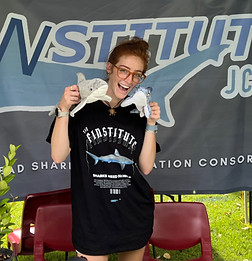
Favourite papers?
Hoyos-Padilla, E. M., Casanova-Santamaria, I., Loria-Correa, J. C., & Sulikowski, J. (2023). The successful use of a submersible ultrasound to confirm pregnancy on free swimming bull sharks, Carcharhinus leucas, in a provisioned shark site. Frontiers in Marine Science, 10
Renshaw, S., Hammerschlag, N., Gallagher, A. J., Lubitz, N., & Sims, D. W. (2023). Global tracking of shark movements, behaviour and ecology: A review of the renaissance years of satellite tagging studies, 2010–2020. Journal of Experimental Marine Biology and Ecology, 560.
van Putten, I., McClean, N., Chin, A., Pillans, S., & Sbrocchi, C. (2022). What Happens After a Shark Incident? Behavioral Changes Among Australian Beachgoers. Human–Wildlife Interactions, 16(1), 10.
Favourite species?
Scalloped hammerhead shark (Sphyrna lewini)
Contact Info:
Aliah Banchik
BSc - Psychology | Tulane University (USA)
MSc - Marine Biology | James Cook University
Aliah is a Master of Marine Biology student originally from New York City. With an undergraduate degree in Psychology, Aliah has a strong background in human behaviour and neuroscience. Outside of marine science, Aliah has conducted research on dyslexia which she later presented in her TEDx Talk at Tulane University. She has also written, illustrated, and published a children's book on dyslexia called “My Best Friend Lexi”.
Aliah is the co-founder of the FINstitute, a shark conservation consortium at JCU that aims to connect students to hands-on learning experiences in the field of shark science while also supporting local Australian and Indonesian shark conservation initiatives.
Outside of the classroom, Aliah is a PADI Assistant Instructor, freediver, underwater photographer, drone pilot, and media specialist whose work has been featured on Canon Oceania’s media pages and ABC News Australia. Aliah is passionate about elasmobranch conservation and connecting with people to make a tangible difference in conservation.
Aliah is currently pursuing a full year of independent research studying Giant Shovelnose Rays (Glaucostegus typus). Specifically, she is interested in understanding what makes successful nursery grounds for these Critically Endangered rays and will be looking closely into their diets in relation to the available nutrients across coastal environments where they are found. She is under the supervision of Dr. Ana Barbosa Martins from the Fish & Fisheries lab as well as Dr. Marcus Sheaves from the Estuary and Coastal Wetlands Ecosystem group.



